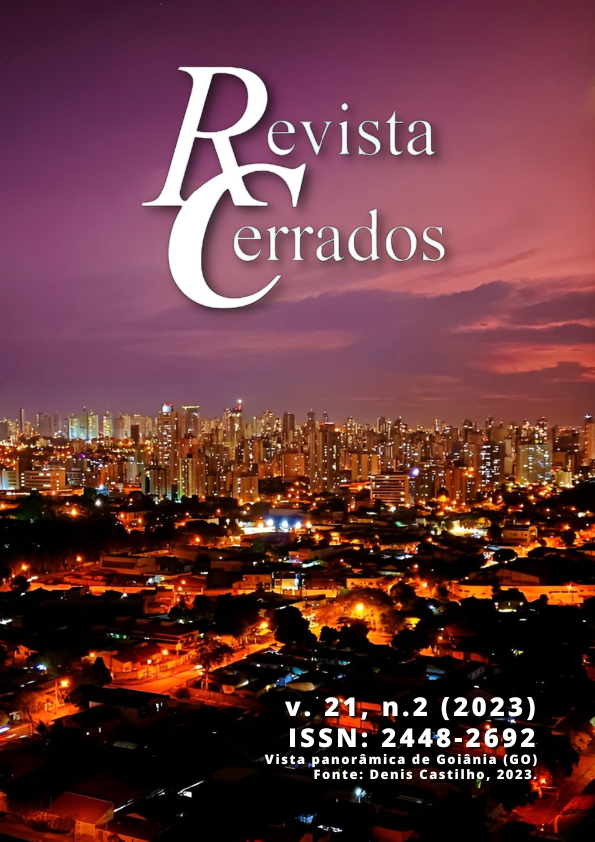Influence of geological, geomorphological and physiographic factors on the fluvial dynamics of the upper course of the Jequitinhonha River in the segment between Diamantina and Couto de Magalhães - Minas Gerais/Brazil
DOI:
10.46551/rc24482692202322Keywords:
Serra do Espinhaço Meridional, Jequitinhonha River, Fluvial Geomorphology, Physiographic AspectsAbstract
The Serra do Espinhaço Meridional is essentially composed of lithologies of the Espinhaço Supergroup, formed mainly by quartzitic, phylitic, conglomeratic rocks, with absolute predominance of quartzites, composing a densely fractured and sheared rigid cover. Serra do Espinhaço is compartmentalized into two geomorphological units: the plateaus, which are very well individualized, and the depression, which is distinguished by a depressed area in a NW-SE direction. Located on its eastern edge, is the hydrographic basin of the Jequitinhonha river, east river, of extreme relevance for the Northeast region of the state of Minas Gerais. Studies approaching fluvial geomorphology are important and relevant to understand how fluvial dynamics influence the hydrological behavior of the river. In this work, the physiographic factors of the fluvial segment of the Jequitinhonha river covering the municipality of Diamantina were analyzed. The physiographic characteristics along this segment directly contribute to its fluvial behavior. Characteristics such as geomorphological features, geological and lithological aspects, climatic characteristics, plant phytophysiognomy, in addition to mining activities, become responsible for changes in fluvial dynamics.
Downloads
References
ALMEIDA-ABREU, P. A. O Supergrupo Espinhaço da Serra do Espinhaço Meridional (Minas Gerais): O rifte, a bacia e o orógeno. Revista Geonomos, Belo Horizonte, n. 3, v. 1, p. 1-18, 1995.
ALMEIDA-ABREU, P. A.; RENGER, F. E. Serra do Espinhaço Meridional: um orógeno de colisão do Mesoproterozóico. Revista Brasileira de Geociências, [S./l.], v.32, n.1, p.1-14, 2002.
AUGUSTIN, C. H. R. R; FONSECA, B. M; ROCHA, L. C. Mapeamento geomorfológico da Serra do Espinhaço Meridional: primeira aproximação. Revista Geonomos, [S./l.], v.19, n.2, p.50-69, 2011.
BAPTISTA, M. B; SPERLING, M. V. Morfologia Fluvial. In: VON SPERLING, M (Org.). Estudos e modelagem da qualidade da água de rios (Princípios de tratamento biológico de águas residuárias, V.7). 2. ed. Editora UFMG. Belo Horizonte, p. 139 – 184, 2014.
CHAVES, M. L. S. C.; CHAMBEL, L. Diamantes do médio Rio Jequitinhonha, Minas Gerais: Qualificação gemológica e análise granulométrica. Revista Escola de Minas, Ouro Preto, v. 57, n. 4, p. 267-275, 2004.
CHRISTOFOLETTI, A. Geomorfologia. 2. ed. São Paulo: Edgard Blucher Ltda, 188 p. 1980.
CHRISTOFOLETTI, A. Geomorfologia fluvial. Volume I - O canal fluvial. 1. ed. São Paulo: Edgard Blucher Ltda, 297 p. 1981.
COSTA, F. N. Campos Rupestres. In: SILVA, A. C.; PEDREIRA, L. C. V. S. F.; ABREU, P. A. A. O. (Org.). Serra do Espinhaço Meridional: Paisagens e ambientes. O Lutador, 2005, 271p.
FERREIRA, V. O. Unidades de paisagem da bacia do rio Jequitinhonha, em Minas Gerais: subsídios para a gestão de recursos hídricos. Caminhos de Geografia, [S./l.], v. 12, n. 37, abr. 2011.
FONSECA, B.; AUGUSTIN, R. Análise morfométrica de bacias de drenagem e sua relação com a estrutura geológica na Serra do Espinhaço Meridional-MG. Revista Brasileira de Geomorfologia, [S./l.], v.15, n.2, p. 153-172, 2014.
GROSSI-SAD, J. H.; ROQUE, N. C.; KNAUER, L. G., NOCE, C. M. & FONSECA, E. Geologia da Folha Carbonita. In: GROSSI-SAD, J. H.; LOBATO, L. M.; PEDROSA-SOARES, A. C. & SOARES-FILHO, B. S. (Ed.). PROJETO ESPINHAÇO EM CD-ROM (textos, mapas e anexos). Belo Horizonte, COMIG - Companhia Mineradora de Minas Gerais, p.1251-1371, 1997.
HOWARD, A. D. Drainage analysis in geologic interpretation: a summation. The American Association of Petroleum Geologists Bulletin, [S./l.], v. 51, nº11, p. 2246-2259. 1967.
INSTITUTO METEOROLÓGICO DO BRASIL – INMET. Normais climatológicas do brasil, período 1981 – 2010. Disponível em: <http://www.inmet.gov.br/portal/index.php?r=clima/normaisClimatologicas>. Acesso em: 26 Out. 2019.
KELLER, E. A.; PINTER, N. Active tectonics, earthquakes, uplift, and landscape. 2nd ed. Pretince-Hall, Inc. Upper Saddle River, New Jewrsey, 2002. 362p.
KING, L. C. A Geomorfologia do Brasil Oriental. Revista Brasileira de Geografia, [S./l.], v.8, n.2, p. 147-266, 1956.
KÖPPEN, W.; GEIGER, R. Klimate der Erde. Gotha: Verlag Justus Perthes. 1928. (Wall-map 150cmx200cm.).
MENDONÇA FILHO, C. V. Vegetação. In: SILVA, A. C.; PEDREIRA, L. C. V. S. F.; ABREU, P. A. A. O. (Org.). Serra do Espinhaço Meridional: Paisagens e ambientes. O Lutador, 2005, 271p.
NOCE, C. M.; FOGAÇA, A. C. C. Mapa geológico da Folha Curimataí, Minas Gerais, Brasil. Projeto Espinhaço. Belo Horizonte: COMIG/IGC-UFMG, 1996.
NOCE, C. M. Geologia da Folha Curimataí, Minas Gerais. In: Grossi-Sad, J.H.; Lobato, L.M.; Pedrosa-Soares, A.C.; Soares-Filho, B.S. (Org.). Projeto Espinhaço em CD-ROM. 1ed.Belo Horizonte: Companhia Mineradora de Minas Gerais, p. 1199-1250, 1997.
SAADI, A. A geomorfologia da serra do espinhaço em minas gerais e de suas margens. Revista Geonomos, [S./l.], v.3, n.1, p.41-63, 1995.
SOUZA, B. T.; SANTOS, M. S.; BAGGIO FILHO, H.; SILVA, R. F. Análise Espacial e Temporal do Uso e Ocupação da Terra Associado a Atividade de Extração Mineral no Rio Jequitinhonha Diamantina - MG. Acta Geográfica, [S./l.], v. 16, p. 166-188, 2023.
SALGADO, A. A. R; VALADÃO, R. C. Contribuição da Desnudação Geoquímica na Evolução da Erosão Diferencial no Espinhaço Meridional-MG. Revista Brasileira de Geomorfologia, [S./l.], v. 4, nº 2, p. 31-40, 2003.
STRAHLER, ARTHUR, N. Quantitative Analysis of Watershed Geomorphology. Amer. Geoph. Union Trans, [S./l.], v. 38, p. 913-920, 1957.
UHLEIN A., TROMPETTE R., EGYDIO-SILVA M. Rifteamentos superpostos e tectônica de inversão na borda sudeste do Cráton São Francisco. Geonomos, [S./l.], v. 3, n. 1, p. 99-107, 1995.
ZERNITZ, E. R. Drainage patterns and their significance. The Journal of Geology, [S./l.], v.40, n.6, p.498-521, 1932.
Downloads
Published
How to Cite
License
Copyright (c) 2023 Revista Cerrados

This work is licensed under a Creative Commons Attribution-NonCommercial-NoDerivatives 4.0 International License.
In this journal, the copyrights for published articles belong to the author (s), with the rights of the first publication belonging to Revista Cerrados. The articles are publicly accessible, free to use, their own assignments, educational assignments and non-commercial applications.


















